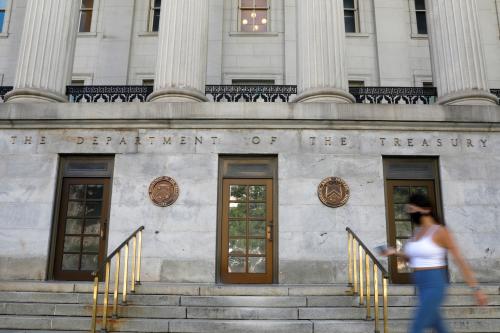This post was updated on March 10, 2022 to correct Detroit’s council district level grant funding.
Love it or hate it, one cannot deny the American Rescue Plan (ARP) and the potential additional federal legislation to follow represent a generational opportunity to change the trajectory of city economies, improve the prospects for suffering citizens, and address long-festering economic and social disparities.
Opportunity is knocking at the door, yet most local governments are struggling to seize the moment. Challenges include a lack of organizational capacity, legal uncertainty, political complexity, and more. A resulting “go-slow” approach is sensible if used to identify goals, shape meaningful investments, engage stakeholders, and align funders. Unfortunately, too few places are proceeding with the necessary urgency and organizational rigor. But some leaders are thinking strategically and decisively, with plans to move beyond immediate recovery to advancing larger visions. Their actions may point the way for others.
This brief contains findings from over 30 interviews with local leaders and association professionals from September and October. These interviews point to seven actions to open the door to more competitive, resilient, and equitable economies. Some are obvious (but typically neglected) such as following a deliberate, intentional planning process. Others reflect more innovation (e.g., non-grant tools, incentives for collaboration) that can scale impact, attract additional funding, sustain the work beyond the ARP timelines, and tackle issues of inclusion head-on. Some actions should proceed immediately; others require thoughtful choices that reflect the needs and context of each community.
The American Rescue Plan’s (potential) new dynamic
The last few decades have been an exercise in penny-pinching for many, if not most, American cities and counties. Local leaders have faced a seemingly never-ending series of tough choices in juggling budgets: cutting safety services to fund a workforce program; postponing a needed sewer repair to keep public pools open; picking which neighborhoods will be wired with broadband and which must wait.
Against this challenging backdrop, the COVID-19 pandemic threatened fiscal calamity. The initial months were bleak. Government revenues plummeted as the service industry—and the various taxes associated with them—collapsed. Transit ridership vanished while the largely fixed costs remained. Businesses laid off or sent home workers, often with the associated employment taxes. Social service needs ballooned. Budget holes of 40% or more in that first year were not unheard of.
In March 2021, Congress passed the American Rescue Plan (ARP). It injects $1.9 trillion into the economy, including $350 billion in State and Local Fiscal Recovery Funds in two tranches over two years. The purpose of those funds was to: 1) address public health needs and economic damage from the pandemic; 2) provide premium pay to essential workers; 3) replace lost fiscal revenue and government services; and 4) invest in water and broadband infrastructure.
Fortunately, several mitigating events improved local fiscal fortunes. Booming demand for produced goods at least partially offset the hit to the service economy. Despite supply chain and labor disruptions, the economy overall rebounded. Economists expect growth of 5.9% this year and output to exceed pre-pandemic levels. Combined with civic belt-tightening, many communities now expect budget surpluses. For many, an improved economic outlook changes the desired impact of ARP local recovery funds from pure relief to broader economic and social change.
ARP allocations represent resource infusions the likes of which haven’t been seen since the 1960s-era Great Society programs. Cleveland, for instance, will receive $511 million; for reference, the city’s 2021 budget is $1.8 billion. Add an additional 162 entities receiving funds in the metropolitan area and the ARP investment is about $1.3 billion. Similar stories abound elsewhere; local government ARP allocations often comprise 25% to 50% of annual budgets.
Beyond the local recovery funds, ARP inflows come from a variety of sources, including the state recovery allocations, the Economic Development Administration, the Department of Transportation, the Department of Housing and Urban Development, the Small Business Administration, and more. Additionally, more federal action is on the horizon, starting with the Infrastructure Investment and Jobs Act, which contains about $550 billion in new spending. Next up is likely the Build Back Better Act currently being negotiated through reconciliation. Although details are subject to change, the current version contains about $2 trillion of spending and, if passed, will provide additional funding streams for local governments to take advantage of.

With such large numbers and a fiscal context that has shifted from relief to broader recovery, how are local governments responding? Are cities using ARP allocations to ameliorate seemingly intractable issues like poverty, health disparities, the digital divide, homelessness, lead contamination, and neighborhood disinvestment, which have caused decades of decline for legacy and other cities?
In addition to questions raised by shifts in need are questions related to the breadth of governments receiving funds. Pretty much every local government unit gets some share of the pot. Moreover, ARP gives communities wide latitude to work together as well as to partner with nongovernmental organizations. Given that housing, labor, and infrastructure markets—and their failures—transcend city boundaries, are leaders taking steps to work across historical silos and achieve true scale and impact?
The above considerations were critical context to this investigation. Most ARP research to date has focused on the “what” of allocations. Our interviews focused on the “how” behind the decisions. What principles are guiding decisions, what capacity is being created, where are leaders getting input, and with whom are they partnering?
The findings so far:
- Most places have been slow to spend or even commit their funding; given the stakes and the time to spend, this is generally a good thing.
- With some notable exceptions, few places are pursuing transformational investment programs; most are simply pushing money out the door.
- While little meaningful cooperation exists across entities in allocating federal resources, several exciting examples exist that might be replicated.
Fortunately, time remains to utilize the unprecedented resources to drive big change. But it will require a sense of urgency, strong leadership, collaborative processes, and a willingness to invest in capacity.
Finding #1: Governments have been slow to spend—and that’s okay
Much has been written recently about the slow pace of local government spending of ARP dollars, including by Brookings. In the initial round of reporting in August, many cities reported no expenditure at all. Of 20 plans sampled, only 18% of available funds had even been committed.
In our interviews with elected officials, several reasons for this slow start surfaced, as did possible ways to navigate the challenges.
- Lack of final guidance from the Treasury Department. By far, the most prevalent reason expressed for the slow commitment of funds is uncertainty about allowable uses. Although Treasury issued interim final guidance on May 17, many leaders are seeking greater specificity or fear potential changes. They cite shifts that occurred between interim and final guidance for the CARES Act. More than one official expressed concerns about an audit, the need to return funds, or financial penalties. Internal wrangling between legal and other departments can result in further delays or caution. Faced with regulatory ambiguity, not all leaders are taking a cautious approach. Industrial redevelopment and brownfield remediation are examples; Erie County, Penn. leaders believe this use fits clearly within the guidelines and have dedicated 12% of their funds to it. They reason that their targeted sites sit among Opportunity Zone neighborhoods and address both economic damage and quality of life. In contrast, Stark County, Ohio leaders have big ambitions for site redevelopment, but feel frozen until they get more clarity from Treasury.
- Strategic gaming—what will come next? As highlighted in Figure 1, ARP local recovery funds are only one source of new funding to local governments. If “flexible” ARP money is spent today on one category, might additional funds be made available later for the same activity, thereby wasting an opportunity? Returning to Stark County, smaller communities there planned to expend their local recovery dollars on much-needed and long-delayed water and sewer projects. But the state of Ohio is also making some of its allocation available for water infrastructure, and additional funding is available in the infrastructure plan. The prudent path for Stark County leaders is to wait for the dust to settle—maybe their local recovery funds are better used to help struggling small businesses prepare workers for jobs, or to revitalize neighborhoods. However, funding may exist for those activities as well. Currently, local ARP allocation is a high-stakes exercise in game theory—or worst case, it creates a bias toward expediency. So, what is a leader to do? More strategic communities are mapping expected and potential federal funding flows against potential uses and assigning probabilities. Greater Minneapolis-St. Paul is one notable example with its Federal Funding Hub, and Portland, Ore. is doing something similar with its Economic Recovery Council.
- Lack of capacity to plan strategically. Perhaps the most potent—yet most solvable—limitation leaders highlighted is the lack of capacity to manage a program of this size and complexity. In theory, leaders might like to work strategically, transformatively, and collaboratively, yet the practical task of doing so is overwhelming. Smaller jurisdictions typically lack in-house technical capacity to understand (and push) the boundaries on permitted uses of funds. Most every government finds that urgent day-to-day necessities crowd out the ability to frame and shape big, systemic programs. Faced with such limitations, communities may go slowly in making choices, pursue only safe and tangible expenditures (e.g., fix a sewer), or invest only in known programs. Of course, this is not always the case. Some places are consciously building capacity either internally or through partnerships, and even using their ARP allocations to pay for it. For example, King County, Wash. set up a new team of seven people inside its Office of Performance, Strategy and Budget to support ARP-related efforts that did not previously exist. Greater Bloomington, Ind. (via the Bloomington Economic Development Corporation) and Minneapolis-St. Paul (via Greater MSP) stand as examples of places leveraging partners to align plans and bolster resources. Other places are going even further in their partnerships. The elected officials in Erie County, Penn. set broad investment parameters and are now turning to outside organizations to scale programming and move money: a newly formed Diversity, Equity and Inclusion Commission, the Erie Area Council of Governments for public safety, and the Erie County Gaming Revenue Authority for “transformation grants.” Austin, Texas has stepped up with $9.2 million dollars toward capacity building around homelessness via partnerships with nongovernmental partners to back an investment of more than 50% of its first-year allocation to this issue.
An important takeaway is that while “go-slow” approaches to allocation may be both natural and sensible, there should be no slowdown in planning and engagement. “Getting it right” might take time, but should not be confused with halting or uncertain planning and engagement.
Finding #2: There are few transformational investment programs
Where local ARP plans have come into place, several philosophies seem to be emerging. Cutting across them is a universal emphasis on maximizing what the legislation categorizes as “lost revenues.” Local governments are smart to maximize what counts as lost revenue because Treasury guidance permits these dollars to be deployed for virtually anything. In the Brookings piece previously cited, nearly 40% of funds committed to date have been for revenue replacement.
Communities’ ambitions and approaches to their allocation decisions vary across multiple dimensions (Figure 2). Of course, each dimension is a continuum that has local nuance, but the endpoints generally reflect the choices confronting political leaders. First is the balance between near-term relief versus long-term civic system changes. Second is the degree to which communities spread resources broadly versus tackling a few issues strategically and intensively. Third, leaders must decide whether their focus will be on their own geography or whether to join other leaders across jurisdictions. Finally, leaders may plan narrowly around ARP local recovery funds, include other ARP programs, or embrace the full range of federal and other funding (e.g., philanthropic, corporate).

Numerous permutations exist across these variables, but four archetypes for spending local ARP allocations are emerging (Figure 3). No individual community fits neatly into any one category, but the archetypes do capture the philosophies and approaches to resource allocation.

- Focus on filling current or anticipated budgetary holes. Many cities are investing narrowly and providing back/supplemental pay to public employees or other deferred costs. This trend is understandable given how explicitly the ARP legislation highlights this use and considering that as of last month state and local government employment is about 900,000 jobs lower than pre-pandemic levels on a seasonally adjusted basis. An interesting variant is local governments waiting to commit funds in case of future revenue shortfalls. For example, in Ohio, central cities currently receive local income tax from suburban residents who worked in the city prior to the pandemic but now work from homes in the suburbs. Many employees will likely continue remote work and central cities will ultimately lose the ability to tax them. The Ohio Mayors Alliance estimated that large cities stand to lose 3% to 10% of general fund revenues. To prepare for this, the city of Canton intends to hold back a portion of its ARP allocation as an adjustment buffer.
- Project-based relief expenditures. Many governments are taking a regulatorily conservative relief focus. Typically, this approach provides direct support to individuals and businesses (e.g., rental/eviction support, small business grants) and/or invests in discrete infrastructure projects (e.g., water and sewer repairs). As one city official put it, “We are using our first-year dollars wholly for relief because any ground we lose now will be that much harder to recover from later.” Government leaders are utilizing numerous vehicles to deliver these project-based relief expenditures. Some places are spreading dollars to council members and their districts, where they function effectively as block grants. Although a small share of overall funds, Detroit provides about $1.7 million per council district for grants to block clubs and neighborhood associations. Conversely, Evanston, Ill. is planning to allocate $2.5 million for participatory budgeting, empowering city residents to have a direct impact on city priorities and expenditures. Certainly, meeting pandemic-driven household and business needs is paramount, but the recipients should take care to avoid spreading the dollars so widely that they don’t add up to lasting change anywhere. Seldom do comprehensive lists of short-term projects add up to transformational impact. However, many cities whose first wave of expenses focused on immediate relief have noted their intention to focus on long-term approaches in subsequent waves of spending.
- Intensive investments in selective initiatives. Some communities seek to concentrate dollars on a subset of issues to achieve more transformational impact. Transformational programs are those that emphasize systems capacity and long-term support. For example, Detroit’s Skills for Life program will invest $40 million over three years to fight intergenerational poverty by providing city jobs at a living wage for residents three days a week and an opportunity to acquire a GED or other credentials the remaining two days. The most common arenas for big systemic investment to occur have been homelessness, broadband, and neighborhood redevelopment. This includes the state of Delaware investing 12% of its allocation to universal broadband access. One of the biggest impediments to substantial strategic investments is sustainability, given that ARP dollars must be committed by the end of 2024 and expended by the end of 2026. Many public officials rue the “one and done” nature of ARP and few have shown significant creativity and/or experimentation to address this. But room does exist for creativity. For example, the interim final guidance from Treasury makes clear that help to small businesses hurt by the pandemic can be supported with loans. Looking beyond business, might loans or “loan-like” instruments be used in other areas to provide sustained funding? For example, JobsOhio, the state’s private economic development arm, provides funding for income share agreements for unemployed or underemployed workers to get the training they need to procure and advance in good jobs. Training costs are replenished through a capped percentage of future income, with the repaid dollars used for the next wave of workers. JobsOhio is also exploring how to incorporate wraparound services into such a model. Indiana is doing something similar with the Regional Economic Acceleration and Development Initiative (READI). Another example of creativity is in Macon-Bibb, Ga. Leaders there have leveraged their ARP funds through a matching grant from the Knight Foundation and established a revolving loan fund for residents to rehab local buildings that can become income-producing commercial rental properties.
- Comprehensive transformational investments. Soon after stimulus funds began flowing, Brookings called for local governments to use funds to advance comprehensive strategies to reverse decades of decline. As the various pieces of ARP came into focus, the upside of a strategic approach seemed even more tantalizing, and the prospect of additional federal funds provides further reinforcement. Yet to date, few examples of coordinated capital planning across geographies, available capital sources, and programmatic areas can be seen. Instead, most places look at programs, funding sources, and other geographies in isolation. However, some promising models can be found. In Portland, Ore., the mayor established an Economic Recovery Task Force early in the pandemic to set priorities for how to use and align federal funding. The Task Force is facilitated by Prosper Portland and includes a broad set of community stakeholders whose work is supported with staff and resources. While the priorities to date have been around near-term relief, the structure could serve well if the focus shifts in the second funding tranche to longer-term, transformational work. With support from elected officials, Greater Minneapolis-St. Paul established a “federal funding hub” to provide technical assistance to local governments and, importantly, align ARP investments with overarching regional plans and attract additional resources. The goal is to increase the federal and other funds available as part of comprehensive and integrated capital infusion. Such approaches can work in smaller communities as well. In Indiana, the Bloomington Economic Development Corporation is working with the county and local governments to coordinate ARP investments.
The takeaways are that communities are well served to use at least a portion of their funds for a few big civic priorities, and that they should map current and potential resource flows from multiple sources to community priorities.
Finding #3: Cross-institutional collaboration is limited
Significant ARP dollars are flowing to multiple governments within the same geography. This begs the question of whether and how local governments are working together to maximize the impact.
The short answer: They’re not, at least as it relates to pooling local recovery fund expenditures. Few examples exist of governments pooling dollars, although there have been notable efforts to align investments.
Several factors stand in the way of joint investing. Political reality suggests few elected officials will want to cede authority over their allocations—after all, they can argue that they were elected at least in part to prioritize capital allocations. Several leaders also indicated that it is complicated enough to work within their own administrations and interact with their own councils. It doesn’t make sense to introduce new layers of complexity by reaching out to other entities.
However, there have been notable exceptions, especially when state or county governments put incentives to collaborate on the table. For example, Indiana is encouraging intergovernmental collaboration by taking a portion of its ARP allocation to support funding of the Regional Economic Acceleration and Development Initiative (READI). READI is a competitive grant program in which self-identified regions put together plans for growth on a 4:1 match basis. While applications have only recently been submitted and it is not clear the extent to which local communities are using their own ARP funds to meet the match, READI is an illustration of how additional financial incentives can encourage intergovernmental collaboration. California has used ARP dollars to create a competitive $750 million Community Economic Resilience Fund that brings stakeholders together around long-term recovery plans. Wisconsin deployed $100 million in ARP funds to bring geographic stakeholders together around workforce innovations.
Additional examples exist of counties providing financial leadership to bring local governments along in programs ranging from broadband to homelessness to infrastructure. Stark County, Ohio, for example, is contemplating using some of its allocation to encourage local governments to coordinate water and other infrastructure improvement plans.
Even if there are not many pooled investment activities, collaboration can be found in efforts to share information, align investments, and attract new money. The previously noted Greater MSP’s federal funding hub or Portland’s Economic Recovery Council stand as examples of such groups.
Much as archetypes exist for the strategies governing ARP allocations, different models can be seen for how these kinds of tables have been created and how they vary by structure and activities. Figure 4 illustrates the range of choices:

The dimensions for coordination include:
- Number of tables: Some places have a comprehensive table that serves as a “coordination tower” across the entire set of ARP (and other) resources; other places opt for tables that are issue-specific. And some places utilize both.
- Purpose: The most limited tables are ones where a broad set of stakeholders are informally convened to provide input and ideas to a single elected official. Other tables exist for multiple funded entities to share their priorities and seek alignment. One step further are tables convened to follow a process that results in a shared strategy. While infrequent, there are tables where funding is pooled, usually to address a specific issue.
- Scope: Most typically, tables focus exclusively on the allocation of ARP local recovery dollars. But examples exist of tables that look at ARP more broadly (e.g., inclusive of Economic Development Administration challenge grants or partnering with states) and, as in the case of Greater Minneapolis St. Paul, augmented federal funding more generally.
- Activities: Closely related to the purpose of a table is what it does. In most cases, the table is simply a place where ideas are discussed with no additional staff. But other places provide staff to support participants, whether that be through regulatory guidance, grant writing, or opportunity shaping. In a few cases, grant-making authority may be vested with the table.
- Breadth/facilitation: Most tables focus on a single government, led by the elected official who invites key civic leaders to participate. In some cases, the leader may task an outside entity such as an economic development corporation, a community foundation, or simply a respected civic institution to facilitate. Tables of multiple government entities also exist, usually convened by counties who invite cities and townships to participate.
- Members: Last is the question of who sits at the table. Typically, when the purpose is limited to input for a single public official, the set of stakeholders is broad. When the purpose is to align priorities or coordinate investments, the stakeholders are most often funding entities. Tables formed around special purposes such as housing, workforce, or the digital divide are likely to include both funders and service providers working in those arenas.
It is too early to know which model will prove most viable—or whether a standard model even makes sense given the diversity of geographies and needs. However, the creation of a coordination tower supported by one or more special purpose tables appears to be an almost unmitigated positive, especially if it has diverse representation, adequate staffing, and a commitment to transparency and engagement (see Figure 5). Almost certainly, special efforts will be required to ensure plans are inclusive.

Call to action: Seven steps toward greater impact
Amidst the uncertainty surrounding ARP, we know several critical pieces of information: the overall fiscal balance has shifted from relief toward recovery; huge dollars are flowing; multiple governments within the same geographies are receiving funds; many sources of funding exist beyond the local recovery funds; and leaders have considerable discretion regarding partners with whom they can collaborate. Drawing from this context and the observations of leaders across the United States, seven “no regrets” actions should be taken now (Figure 6).

- Take the time to do it right and be explicit. Seldom does it sound right to say “go slow,” but that may be the best course for many communities. CARES Act money had to move quickly to alleviate distress and stave off economic calamity. Circumstances are still tough, but the situation is different. Leaders should not rush to spend or allocate money absent a clear plan for how ARP fits into a broader community strategy. At a minimum, communities should not race to commit their second ARP tranche until they better understand what additional federal funding may be coming and be more strategic about how the funds can be used for lasting impact. Importantly, deliberation should not equate to delay; the size, complexity and number of concerned stakeholders suggest that conducting the necessary stakeholder engagement, program formulation, and due diligence may require months. For communities that lack an existing plan, the task is even greater. Given that so many allocation discussions to date have been haphazard, the urgency is greater than ever. A critical component of planning is to establish clear guiding principles and definitions of success. Elected officials face broad choices about the use of ARP funds. What should be the balance between relief funding (e.g., direct payments to individuals and businesses or hardship pay) versus recovery funding (e.g., workforce training, neighborhood redevelopment, small business loan funds)? What are the priorities across program areas? Is it better to scale existing successful programs or launch new efforts? Is it better to do a few big things or a lot of smaller things? No doubt, most elected officials have this at least implicitly in their heads as they formulate their plans. But communities will benefit from explicit declarations—and even debates—about these issues. Leaders should then establish goals and milestones so that they can make course corrections as events unfold. While this may sound like Management 101, most plans today read more like financial statements or capital project lists than true strategies.
- Treat ARP allocations as a potluck, not room service—convene tables of funders and others to share information, align priorities and expenditures, and pursue new funding opportunities. Communities can regard the tsunami of federal funding with its myriad sources in several ways. For most, it appears to a game—or multiple games—of “whack-a-mole,” with each individual recipient institution reacting to each discrete funding opportunity in isolation from everything and everyone else. The result is likely to be multiple, disjointed lists of one-time and possibly sub-scale projects. The alternative is to envision the funding as a shared community potluck. In this metaphor, the various funding sources are the food items, the various receiving entities are the providers of the dishes (for which some may choose to cook together by pooling funds) and there is a host who helps the group come to consensus about the theme(s) for the dinner and ensure there is enough for each course of the meal.
- Construct a funding GPS by mapping current and potential capital flows to a shared strategy or set of priorities. Ideally, a mapping strategy should link two sides of a ledger—on one side is a shared community strategy or at least a set of agreed-upon priorities, and on the other side, all the potential funding sources. The various county and city recovery fund allocations are just the starting point. On top of this are the many other current expected sources of federal funding plus additional state, philanthropic, and private sources. Of course, the map will shift as funding probabilities change, but at least leaders can have an active, shared conversation about strategic capital allocation. With such a map in hand, cities may be able to leverage additional funding. For example, Detroit has set aside $30 million of its ARP allocation to serve as match funding to attract additional resources.
- Don’t try to fit 10 pounds of flour into a five-pound bag—invest in capacity, either in-house or via partners. It borders on insanity to think that existing civic infrastructures can optimize and manage the massive new inflows of capital. Even if the intention is only to scale existing successful programs, the sheer task of deploying the capital, exercising due diligence, establishing metrics and milestones, and ensuring regulatory compliance is enormous, especially for communities that have spent a decade or more reducing government staffs. For places that have transformational ambitions regarding ARP, even more capacity is required. The good news: It appears that ARP funding can be used to fund such capacity, and moreover, partner organizations across the country appear ready to step up and supplement government resources.
- Think beyond the grant and use funding mechanisms and strategies that promise more sustained and scaled impact. Perhaps the biggest surprise in our interviews was the limited extent to which communities are utilizing non-grant instruments for ARP. Issues like homelessness, neighborhood disinvestment, or workforce development are large and ingrained. Two or even four years will not be enough to overcome the myriad forces that led to them over decades. Communities must find ways to stretch their dollars. Part of this is by using funds that can recycle; it can also mean building systems and capacity to sustain change over time. Additional potential may exist through combined action. Local governments are not likely to collaborate—much less pool their resources—on their own, but states and counties can play a powerful role by using some of their own allocations and convening power to bring local governments to the table.
- Establish a federal funding hub. Almost every geography will benefit from the creation of a central resource hub to support local governments, both in the present round of ARP funding and beyond. Where this unit sits does not appear to be critical—it can be within a single government, lodged with a trusted nonprofit, or simply be a contracted consultant. More important are the functions such a capability provides. A properly resourced hub can summarize plans, provide regulatory guidance, share and normalize data, facilitate decisionmaking, identify additional funding sources, write grants, and track and communicate results.
- Choose one or two areas for sustained and transformative impact. Even though ARP is large, the resources are not enough to do everything—but they can do something. For leaders who have spent years trying to instigate transformational change amidst resource scarcity, the thought of not moving at least one dial is simply too painful to consider, no matter what other near-term exigencies may exist. Yes, uncertainties and challenges are high, but the fight is worth it whether the issue is lead abatement, place-based activation, or comprehensive wrap-around job training and support services.
At various junctures in American economic history, national responses to large-scale events have created make-or-break moments for local governments. Examples include western expansion and national infrastructure, the Civil War and Reconstruction, the Great Depression and the New Deal, and civil rights and the Great Society. The global pandemic and the massive federal response appear to be one of these make-or-break moments. Given the stakes, local leaders simply must fling open the door when opportunity is knocking.
The Brookings Institution is committed to quality, independence, and impact.
We are supported by a diverse array of funders. In line with our values and policies, each Brookings publication represents the sole views of its author(s).






